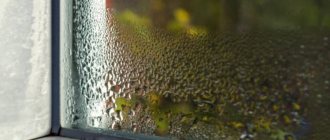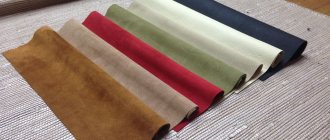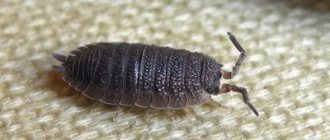The well-being and health of its owners depends on the state of the microclimate in the apartment. The level of humidity is one of the main indicators characterizing the parameters of the air that people in the room breathe. Therefore, it must be periodically monitored. This indicator must remain at the level established by sanitary and hygienic standards.
Therefore, the residents of the house are faced with the question of how to determine the air humidity in the apartment. Various methods are used for this. Even without special instruments, anyone can measure the humidity level in a room. Existing methods will be discussed in detail below.
Why measure humidity levels?
When studying the question of how to determine the air humidity in an apartment, it is necessary to consider first of all what this indicator affects. This will allow you to assess the importance of carrying out such a procedure.
The indoor air humidity should not be higher or lower than the specified range. While indoors, a person may not immediately notice that the surrounding conditions do not meet the requirements of sanitary and hygienic standards. But over time, such violations can affect the health of the owners.
Due to increased humidity, asthma and allergies develop. A reduced value of this indicator leads to disorders of the mucous membranes, decreased immunity, and skin aging. Children are especially sensitive to unfavorable living conditions. Therefore, parents are simply obliged to monitor the level of humidity in their apartment.
Permissible value
When studying the question of how you can determine the air humidity in an apartment, you should consider the permissible values of this indicator. It should be noted that humidity is measured as a percentage. This is a fraction of the primary mass volume of moisture.
Experts say that the optimal value for the room is 45%. In this case, its deviation in both directions is allowed. Thus, the humidity in the apartment should not fall outside the range of 30 to 60%.
There are standards that determine air parameters depending on the purpose of the room. In a living room or dining room the range is 45-60%, and for an adult bedroom it is 40-50%. In the children's room the humidity should be higher. Normally it is at the level of 45-60%.
But for a library or office it is important to maintain this figure at the level of 30-40%. This will protect documents and books from premature destruction. In a kitchen or bathroom, humidity can range from 40 to 60%.
Effects of high humidity
Delving into the topic of how to determine the air humidity in an apartment, you should clearly understand the consequences of deviation of this indicator in both one and the other direction. Inconsistencies are a warning sign.
The first sign of high humidity in an apartment is condensation on the windows. At the same time, all things and furniture in the room are exposed to dampness. Then a specific musty smell appears, and fungus begins to develop in the corners and on interior items. Mold is an unsafe neighbor for humans. It causes serious deviations in well-being and causes a number of ailments.
The consequences of high humidity can be allergies or even asthma, and a decrease in the functions of the immune system. Diathesis sometimes occurs in children. Headaches and diseases of the cardiovascular system are also a consequence of an unsuitable microclimate. Bronchitis and otitis media also develop in similar conditions. Cancer cells also develop faster in high humidity conditions.
Effects of dry air
From the above it follows that everyone should understand how to find out the air humidity in an apartment. A low value of this indicator is also dangerous. This situation occurs especially often during the hot season.
First of all, all dust, wool and other particles begin to freely rise and move with air masses. They do not settle on interior items and freely enter the human body.
Moisture from the skin begins to evaporate rapidly. This causes the body to quickly cool down. Also, the mucous membranes of the body begin to dry out. The protection of organs from harmful microorganisms is reduced. Fatigue and drowsiness appear.
Dry air has a particularly negative effect on children's bodies. Such an indoor microclimate leads to kidney problems and also contributes to the development of dysbacteriosis. Moreover, even an adult organism is susceptible to such effects.
Air in the apartment: humid or dry
Dry air filling the apartment negatively affects the mucous membranes. The respiratory tract, nasopharynx and eyes are most affected. Ultimately, problems with the skin and immunity may appear, and a person may get tired quickly. In an atmosphere where there is a lot of moisture, you can get allergic diseases, asthma and rhinitis. In addition to everything that was mentioned above, we should not forget about the impact of the environment on the apartment itself. If the space is filled with dry air, then all the filling, square meters of housing, furniture, parquet, linoleum, wooden products will begin to deteriorate and to some extent shrink, causing cracks. The premises become filled with dust, dust mites appear, and microorganisms begin to multiply. What can become a source of increasing humidity in an apartment? These are: cooking, number of plants, washing and drying clothes and clothes, taking a bath or shower. On the other hand, high humidity is the main reason for the appearance of mold, which will be very difficult to get rid of in the future. The consequence of all this can be serious health problems.
Hygrometer
A hygrometer is the most reliable device for measuring indoor humidity. Its error should not be more than 1%. Multifunctional devices are on sale that also display room temperature, pressure, etc.
However, many owners are interested in the question of how to determine the air humidity in an apartment without a hygrometer. After all, this device is not always at hand. Buying a hygrometer is still worth it over time. But other methods can be used to assess indoor air humidity. This will make it possible to quickly take action to eliminate serious deviations.
Measuring humidity with a thermometer
One way to measure indoor humidity without a hygrometer is to use a thermometer. This is a simple procedure. How to determine the air humidity in an apartment using a thermometer should be considered in more detail.
There is a certain procedure. You will need a regular mercury thermometer. With its help, you must first measure the ambient temperature. It is better to write down the readings so as not to forget.
Next, wrap the thermometer nose with damp gauze or cotton wool. After 10 minutes, the device readings should also be recorded. The second value is subtracted from the first indicator. Next, using Assmann's psychometric table, you need to find the level of humidity in the room.
Humidity standards in the workplace
Optimal indicators are determined taking into account the specifics of the work. Different production options have their own standards.
If we are talking about relative humidity in the office, then the parameter will be approximately the same as in the apartment - 40-60%. High humidity may cause problems with equipment and papers.
However, office premises are characterized by another problem - “over-dry” air.
What equipment should I use to regulate humidity levels?
Among all the variety of equipment that allows you to regulate the level of humidity, ventilation equipment can be particularly highlighted. By installing it, you can solve two problems simultaneously:
- Ensure the flow of fresh and purified air through filters, necessary for the health of every person.
- Normalize humidity levels.
By contacting, you can order the installation of guaranteed high-quality ventilation and climate control equipment. Experienced specialists will help you decide on the location, type, power and any other parameters of the equipment.
Let's consider the features of the most popular options for multifunctional ventilation devices.
- Recuperators
Devices whose main task is to transfer thermal energy from exhaust air to flowing air masses entering the room. Thermal energy refers to both refrigeration and thermal energy. Because The supply air can receive both cold and heat from the exhaust flows, respectively, cooling or heating.
Most often, ventilation systems with recovery are installed to enable effective energy saving: the air removed from the room is used in the warm months for preliminary dehumidification and cooling, and in the winter - for humidification and warming of the supply air masses with insignificant energy consumption, which goes only to the operation of the fan.
Air recovery technology really makes it possible to minimize both energy consumption and refrigeration and heating loads. With design cooling, it is possible to reduce the maximum peak electrical loads and use less powerful and more economical cooling and heating equipment.
But we should not forget about another important function of recuperators - air conditioning devices can provide (literally under any conditions, including high air humidity outside) optimal relative humidity levels in the room.
Useful energy from the air removed from the room is generated with one important condition - the air flows should not mix with each other. Those. exhaust contaminated exhaust air cannot come into contact with the supply air. Ventilation systems can provide such energy at any time of the year.
On cold days, the recuperator will “free”, using the exhaust air, heat the supply air masses: both the first and second will enter the heat exchanger. The power of a water or electric heater will be significantly saved thanks to such heating.
Let's consider an example of the operation of a recuperator: the air temperature in the room during the winter months should be about +18 degrees. Celsius. The air temperature outside reaches -26 degrees. Celsius. The heater power in a network that does not have recovery should be determined by the formula: 18 + 26 = 44 g. Celsius.
If the ventilation system has a recuperator, then the supply air flows can heat up due to the exhaust masses, say, up to +10 degrees. Celsius. Accordingly, the heater power must be determined taking into account other calculation results: 18 – 10 = 8 g. Celsius. Because Since the heater power depends on the temperature difference, installing a recuperator allows for impressive savings in the power of the ventilation unit.
Glass of water
Another simple method is the glass of water method. This approach is not very accurate, but it will help determine significant deviations in the microclimate of the room. How to determine the air humidity in an apartment using a glass of water is discussed below.
There will always be the necessary items for research in the house. The glass glass must be filled with cold water. The contents should have a temperature of 3-5 °C. The glass must be placed in the room. There should be no heating devices nearby.
If the walls of the glass fog up, but after 10 minutes. dried out, the humidity level in the room is very low. If, after this period of time, drops of the fogged glass flow from its surface, the indicator is very high. If the humidity is within acceptable limits, condensation does not collect in drops and does not flow off the glass.
Air humidity in apartments
This factor is closely related to the health and tone of the residents living there. The heating season brings not only increased temperatures to the house, but also increased dryness. The human body reacts sharply to such changes, causing serious diseases. What is the harm of dry air and what are the options for increasing humidity. Our children are very sensitive to this problem. At the very beginning, you should measure the humidity and only then keep it within normal limits. The premises where its owners live are anthropogenic ecosystems, where comfort and cleanliness depend on them.
Solution
Having considered how to determine the air humidity in an apartment without instruments, you should learn methods of dealing with microclimate non-compliance with standards. When the indicator value is low, special humidifiers are used. They are presented in a wide range on sale. You can also place a damp towel or container of water on the battery. You should also pay attention to growing a sufficient number of indoor plants.
If the humidity is high, you can purchase special devices. They use various methods to remove excess water from the air. Experts also advise regular ventilation. This must be done even in rainy weather. Some rooms may require installation of a hood.
Having familiarized yourself with the methods for determining air humidity in an apartment, you can quickly and accurately assess the state of the microclimate in the room. This will allow you to take appropriate measures in a timely manner and return the indicator to within the standards. The health and well-being of people living in a house or apartment depends on this. Therefore, special attention should be paid to moisture measurement issues.
Increasing air humidity in your own home
There are several options that can painlessly keep the desired indicator normal.
Humidifier
It’s not worth saving on appliances and risking your health. This device is easy to use, silent in operation, and does not consume a lot of energy. A humidifier that sends out ultrasounds ionizes the air and sends a stream of steam into the existing room temperature. In other words, the device adds cold steam to the air. Thanks to the device, you don’t have to worry about children who want to try and touch everything with their own hands. When choosing a humidifier, you need to focus on the area of the room that it can treat. The maximum capacity of the container is 3 liters. This amount of liquid can ensure continuous operation, depending on the set power level. It would be nice to have a hygrometer along with the humidifier that indicates the percentage of moisture. This is necessary in order to prevent over-humidification of the air. Such devices are necessary to have in every home. We regularly ventilate the room Do not forget about the unwritten rule, even when your apartment has a hygrometer and a humidifier. In frosty weather, the air is not entirely humid, but it can still keep germs safe.
Adding moisture through folk remedies
Arrange drying of clothes in your premises; in addition, you can place a container of water on the radiator to evaporate. The more indoor flowers, the better. Watering them will improve the microclimate in the apartment. You can do fish. A thirty-liter aquarium does not give much effect, but a 200-liter tank, although it will be more expensive, will be the most effective humidifier. There are companies that rent them out specifically for the heating season. It's practical and convenient. Using available household means to increase humidity will be an ideal help for those who have not yet bought or do not trust moisture control devices.











